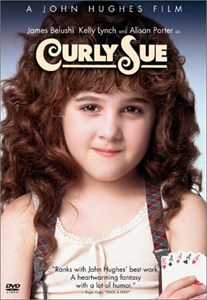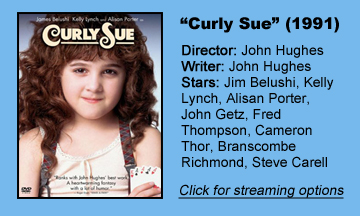After his four high school films as a director, John Hughes moved on to four family friendly films – the last of which is the strangest: “Curly Sue” (1991). On one level, this is another easy-to-like yarn about family and friendships. Chicago has never looked better in a Hughes film, as cinematographer Jeffrey L. Kimball showcases both halves: the glitzy side and the seedy side.
The latter half is still appealing because it features our lovable, homeless title kid (Alisan Porter) and the surprisingly principled dad (Jim Belushi as Bill Dancer) who devises small-time cons to get their next meal.
Can’t exist in reality
Georges Delerue’s delicate piano score combines with Kimball’s visuals to indicate this is a sweet fable about a career-minded lawyer, Grey Ellison (Kelly Lynch), who gains color in her life via Bill and Curly Sue. An alternate title might be “The Ice Princess and the Paupers.”
OK, so why is “Curly Sue” strange? Because there’s no way it can exist in reality. That’s a jarring switch from “Planes, Trains and Automobiles,” “She’s Having a Baby” and “Uncle Buck,” which are grounded in universal issues.
While the climax does involve Curly Sue being taken away from her unfit dad by the state, Hughes doesn’t explain how a 9-year-old could be living on the street for so long up to this point.
In fact, Hughes peppers in a mystery about whether Bill is her biological dad, or whether they are two random homeless people who found each other. When Grey asks Curly Sue why she calls her dad by his first name, she says it’s so she can yell his name and find him in a crowd.
Young actress Porter, through Hughes’ coaching, plays it as a lie. But later Bill tells Grey that he is Curly Sue’s father: She was conceived via a one-night stand, and he acquired her when her mom died in childbirth. Bill has raised her from infancy.
So the idea of them not being related is a red herring. But a father and daughter living on the streets or, alternately, working as a makeshift adult-kid con team are both worth exploring in full. So the waffling adds mystery to “Curly Sue” but prevents us from digging into one of these two interesting concepts.
A non-sitcom ‘Punky’
As a fable, though, “Curly Sue” is consistently lovable, as the kid plays out the “Punky Brewster” origin story without it evolving (or devolving?) into a sitcom. As is common for Hughes, he uses archetypes for most of the main characters – the most extreme case being Grey’s boyfriend Walker (John Getz), who believes homeless people should be out of sight and out of mind of well-to-do folk.
Bill, however, doesn’t fit an archetype. He’s homeless, but this is by choice more so than hard luck. He gets a temporary job on a construction site and says he feels good about it, even though having a job isn’t really his thing. He’s maturing, but maturing too late to an arguably criminal degree, considering that his daughter lacks a roof over her head.

Belushi is great in this role that’s utterly bizarre if you really think about it. Bill purposely has his kid living on the street and only sporadically attending school (she doesn’t know how to read) and instead learning to be a master at small-time cons. Yet he teaches her one core value: They don’t steal. Curly finds hundreds of dollars in cash in Grey’s purse and puts it all back.
The “no stealing” edict has a lot of wiggle-room, though. Bill pretends to be run over by Grey’s car so he and Curly Sue will score her sympathy and a free meal.
Later, a montage shows Grey won over when Bill and Curly Sue show her a good time on the town without money. They sneak into a crowded movie theater and steal a guy’s popcorn and soda. (How’s that for a sequence that plays differently during the coronavirus pandemic?)
Loving, but irresponsible
“Curly Sue” serves up this cute brand of light humor to balance the serious issue of homelessness. It argues that a loving parent might be more important than a responsible parent, and that kids can learn things outside of school. But it ultimately contends that Bill can’t and shouldn’t keep Curly Sue in this lifestyle forever – and that he himself would be better off with a job and home, too.
The gender-switched aspect is also fun to mull over. In the Hughesian “She’s All That” (1999), a popular, fashionable teen boy transforms an unpopular, unfashionable teen girl into someone who can stand by his side without a second glance. Most viewers consider that a standard, predictable plot of a male helping a female.
In “Curly Sue,” it’s the woman who transforms the man; it even includes a scene where Grey sees Bill in a new suit and is amazed by the transformation. So that’s kind of neat.
When Hughes directs his own screenplays, he holds back from going big, though. That’s what makes his films avoid being overly corny. The sentiment at “Curly Sue’s” heart is never buried by over-the-top set pieces or earth-shaking conflicts.
But it also makes his final film as a director kind of weird, because if your brain wanders for even a second toward the plausibility of this story, it totally falls apart. Meet “Curly Sue” on its own playing field, though, and it’s another small Hughes delight.


